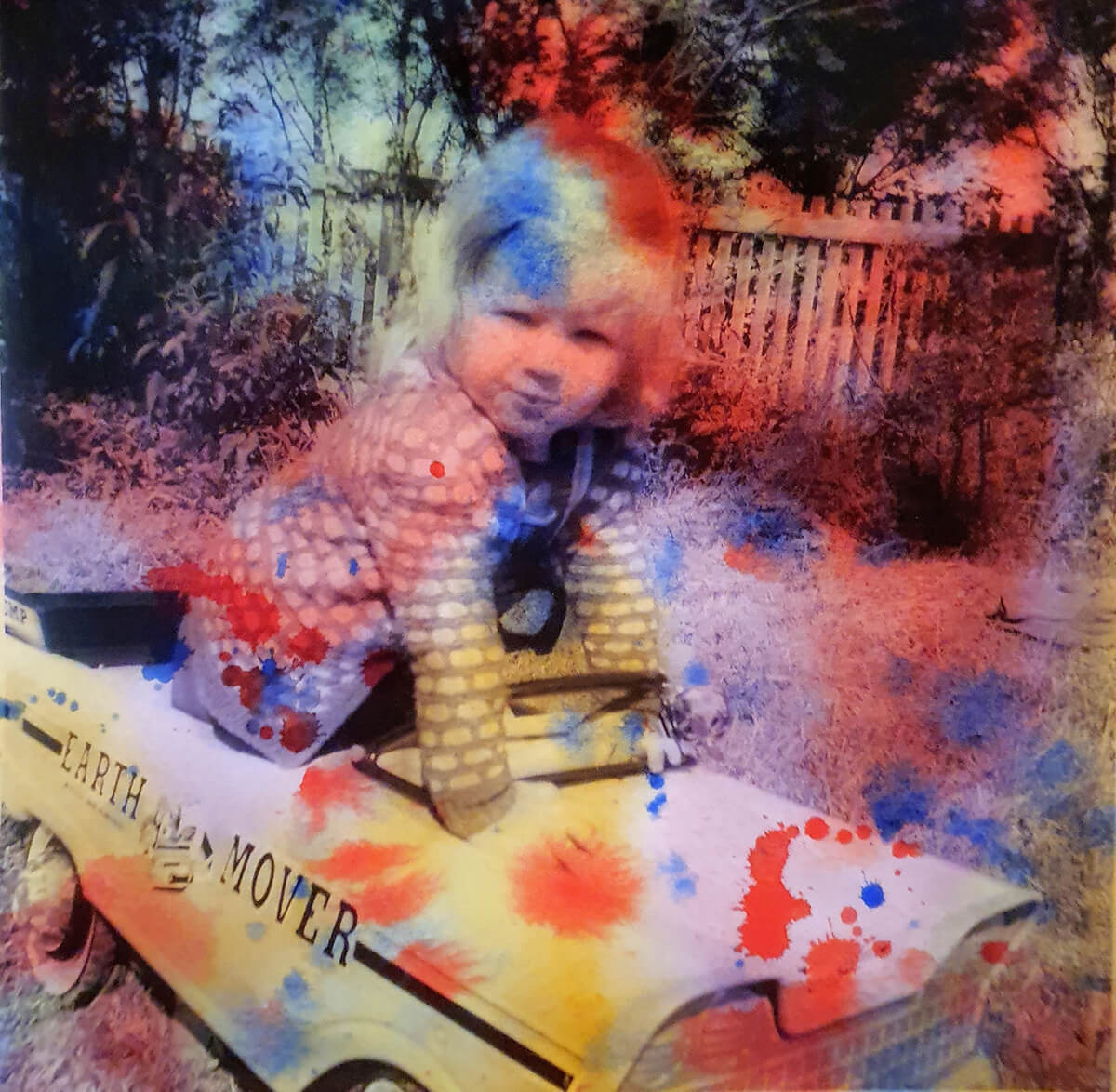
Memory. Unnur Ottarsdottir, 2020. (Photograph by Ottar Yngvason).
Unnur Óttarsdóttir opens her exhibition Memory at tre Grafiksalur, Tryggvagata 17, Reykjavik, entrance at harbor side. The opening reception is on January 16th, 2-5pm. The exhibition runs until January 24th. The gallery is open from 2-5pm, Thursday–Sunday.
Memory, memories and how fragile, abstract and unspoken memory can be, is observed in the artworks at the show. Through paintings, photographs, videos and printed matter, a light is shed at the nature of memory and how non-verbal it can be. Emotional memory flows in colors and shapes. Photographs contains memories and tell stories. A life story is told through works of art.
During the exhibition, free workshops will be offered where memory and memories will be worked with by viewing works of art, conducting memory exercises, studying, participating in art making and discussions.
The workshops will take place on 19, 20 and 22 January at 19.00-22.00.
he maximum number of participants in each workshop is 6 individuals. Please register here: https://forms.gle/enx5FGqKVa4V4zGW9.
Guests are reminded to follow the current infection control guidance. Hand sanitizer is available at the entrance, guests must wear masks and respect the two meter rule as much as possible.
Do you want to unleash the creativity within you and your clients? Do you want to understand how thoughts and emotions are expressed through art making? Do you want to know how you can increase strength and facilitate well-being through the process of making art? Do you want to increase your understanding of imagery and symbolism of art?
The course is intended for everyone interested in art therapy, including those who seek to study and work with art therapy professionally. The course is also useful for professionals who are searching for a better understanding of the art-making process in order to facilitate well-being and personal development of their clients and students.
Insight into the basic concepts and methods of art therapy is offered in the course by means of lectures, reading, written assignments, discussions and workshops, whereby students take part in the creative process and experience the opportunities facilitated. Knowledge of one’s own art making increases self-awareness and gives participants the tools to help others who might find themselves in trouble. A number of ways to create artwork will be introduced in the course, with the aim of increasing creativity, strengthening identity, fostering communication, facilitating self-awareness and improving well-being. Prior knowledge or experience of art is not required for participation.
One of the course locations is the Continuing Education Department at the University of Akureyri. For further information please contact us via email: unnur@unnurarttherapy.is or simenntunha@simenntunha.is.
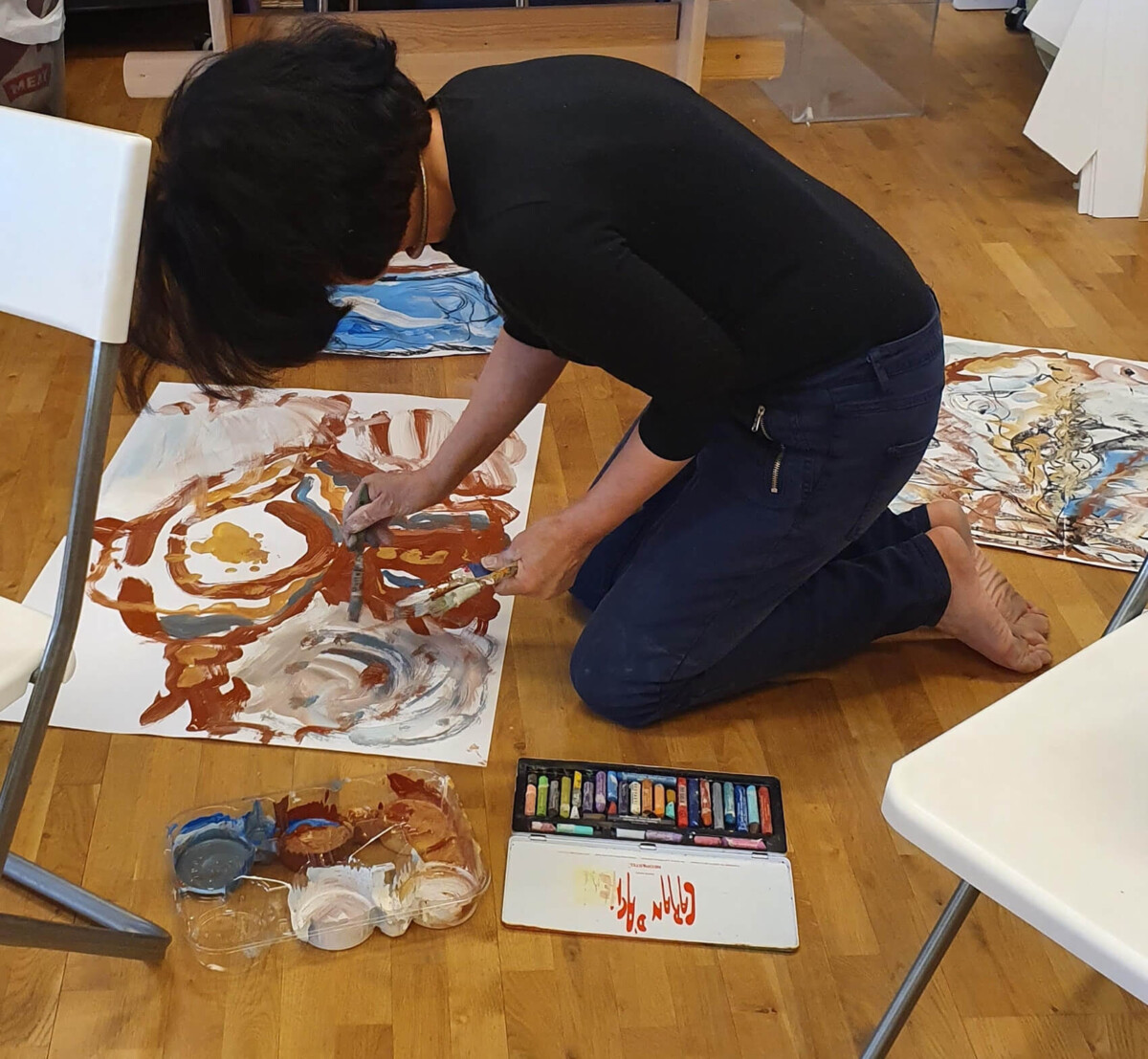
“The knowledge I gained from attending the course has been of great use to me throughout my career of working with children and adolescents, and it still is. I learned to understand that the art created by the children and teenagers who I work with has important underlying meanings. What I learned in the course has proved useful for understanding a wide variety of symbols and signs in the artwork.
My understanding of the art has in some cases opened up a dialogue with the students which I have then been able to share with other professionals. For example, I have managed to present difficulties which the children express in their artwork at team meetings with other professionals.
Sometimes the message in the children’s artwork is quite clear. Art teachers and other staff are in a perfect position for developing an understanding of an individual’s condition and overall well-being through the images they create. I think the course should be part of the core of teacher education programmes. I would be the first person to attend a continuing art therapy foundation course for professionals.”
“What you offered to us who participated in the course was an opportunity to stop, look, review and rethink. Your presence allowed us a certain freedom to be, just be present there and then in the moment, which can only be created through respect for the individual and belief in the individual's abilities. You gave us a framework and I think we all adjusted to it without fear of being judged. What we learned about art therapy and the insight you provided into that world was immeasurably valuable for me. Giving keys to that world to someone who is ready to open up will increase our possibilities to work on and support ourselves and others. You are a great teacher, Unnur, and hopefully I will get the chance of meeting you again soon and experience and learn more and more and more.”
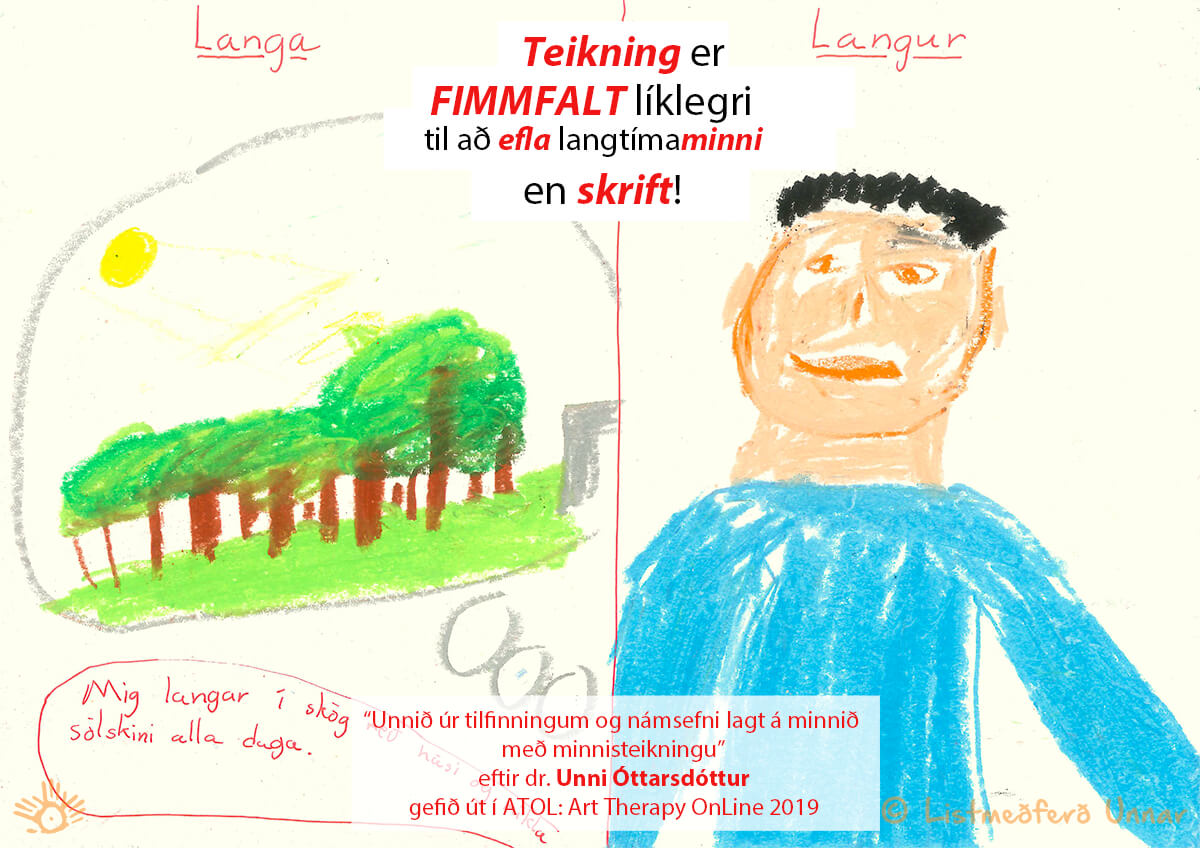
Dr Unnur Ottarsdottir, art therapist, teacher and artist, will be hosting free webinars on “Processing Emotions and Memorising Coursework through Memory Drawing”, in which research findings about drawing and memory will be introduced. The webinars are open to everyone interested.
The research was conducted by Ottarsdottir in two related parts. One hundred and thirty-four subjects participated in the part of the study where they were asked to draw the content of certain words and write other words down. Some subjects were asked to remember after three weeks what they had written and drawn, and others after nine weeks. In both cases, words that were drawn were generally recalled much more successfully than words that were written. Drawing was generally as much as five times more effective then writing when recalled nine weeks after the original memorisation. To the best of knowledge, research regarding such long-term memory of drawings has not been conducted worldwide, prior to now.
In the other related part of the research, Ottarsdottir conducted a qualitative study with five children who had experienced stress or trauma and had specific learning difficulties. The children drew pictures partly to memorise coursework material. Indications were found that such drawing could facilitate processing of emotions associated with difficult or traumatic experiences.
Art therapy theories and methods were found to be important in order to understand the memory drawing process. It appears that drawing, in art therapy, provides sufficient safety so that the children often manage to express vulnerable and complex feelings more easily through drawing than they do through speaking. The memory drawing research is contextualised within the literature on related research studies, methods and theories.
Participants in the webinar will be invited to take part in a drawing/writing exercise which explains the way in which the quantitative part of the research was conducted. The exercise provides insight into the functions of memorising through drawing and writing.
Ottarsdottir is available for giving lectures on demand, about the memory drawing. To schedule a lecture, contact her through email unnur@unnurarttherapy.is or by phone at 00354 8670277. The full paper on the research, “Processing Emotions and Memorising Coursework through Memory Drawing”, was published in ATOL: Art Therapy OnLine, and can be viewed here.
Ottarsdottir will be hosting webinars.
Timing of the webinars will be announced later.
Attendance to the webinars is free and open to everyone.
"I was spellbound after Unnur‘s webinar on art therapy and her account of her research, I found it very impressive and interesting to partake in the experiment we did during the lecture, and my own results really came as a surprise to me. As the lecture is two hours long, I found it good to get a ten minutes break after one hour, as you don‘t need to be stressful that you might miss something if you need to use the bathroom or just grab a cup of coffee. Thank you so much, Unnur, for the information and for a good time."
"Unnur facilitates her webinar gracefully, is exceptionally well organized, and shares knowledge that can immediately inform one's life personally and professionally. It was to me an intellectual coming home - a rarely struck harmony of theory and practice."
I gave a lecture on memory drawing at the 50th anniversary American Art Therapy Association Conference, 31st of October 2019, where I talked about my research on how effective drawing is for increasing memory and processing emotions. It was great to meet with so many art therapists from around the world, learn about their art therapy work and to share with them the memory drawing research.
In the pictures I’m with Bobbi Stoll the founder of the International Networking Group of Art Therapists. Also, with lovely Judy Rubin who has contributed greatly to the development of art therapy through for example; writing books, making films and being supportive to other art therapists. I’m also with the art therapist Audrey de Maria who is the editor of the book "Exploring Ethical Dilemmas in Art Therapy: 50 Clinicians From 20 Countries Share Their Stories". I wrote a chapter in the book and it was a great pleasure to see Audrey at the conference.
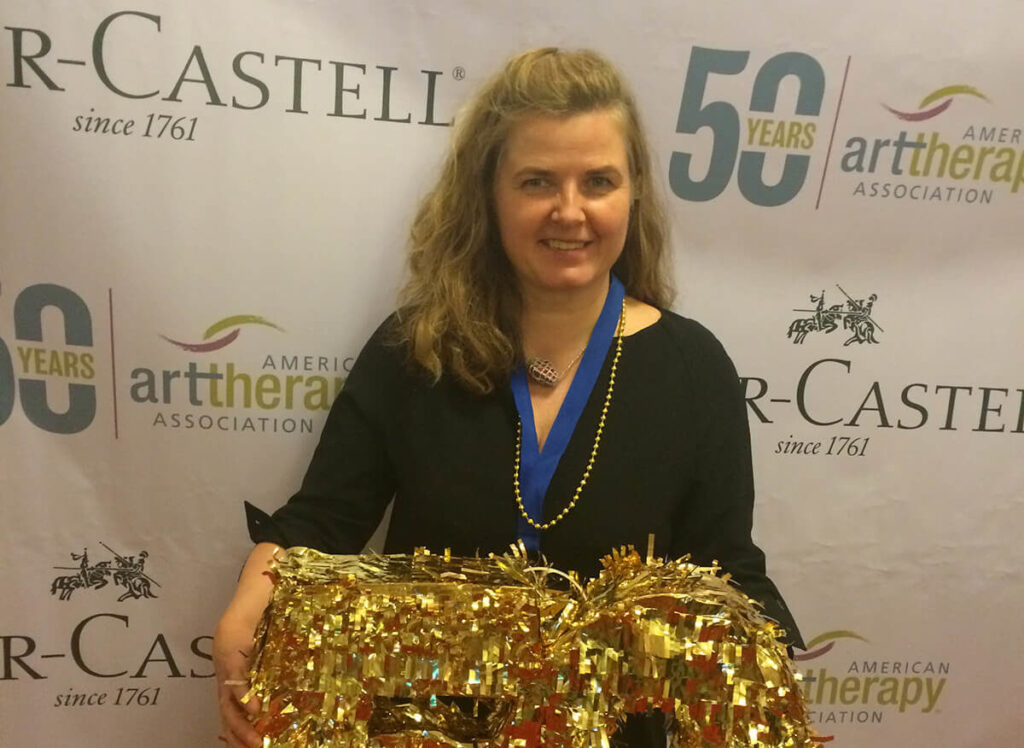
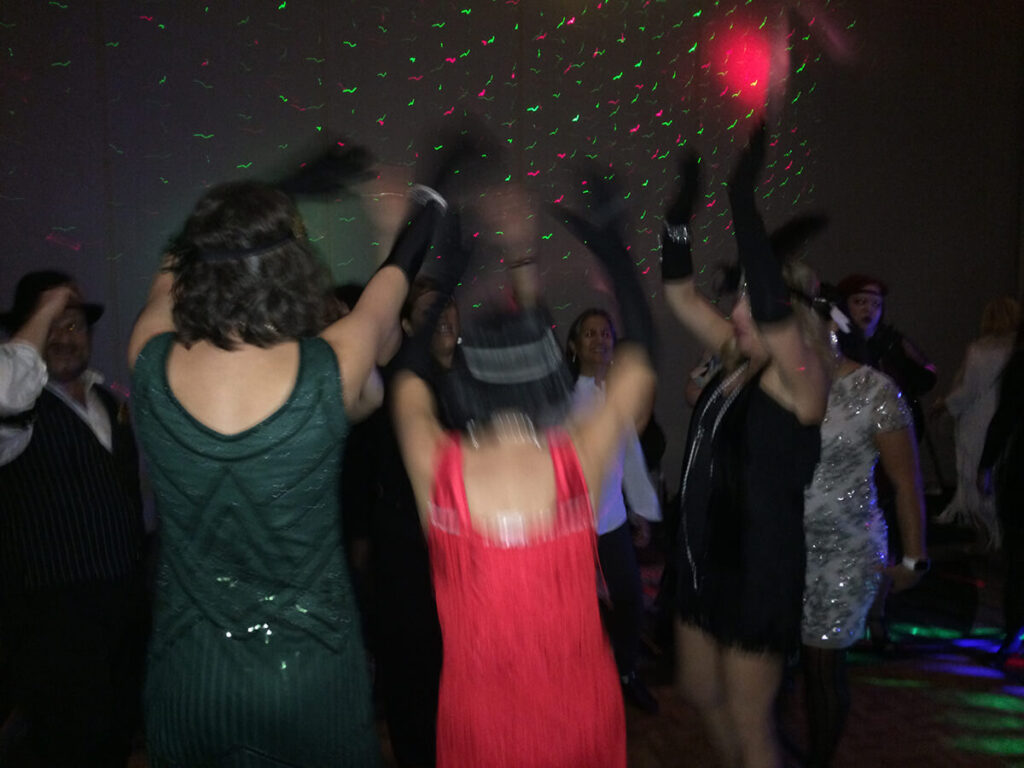
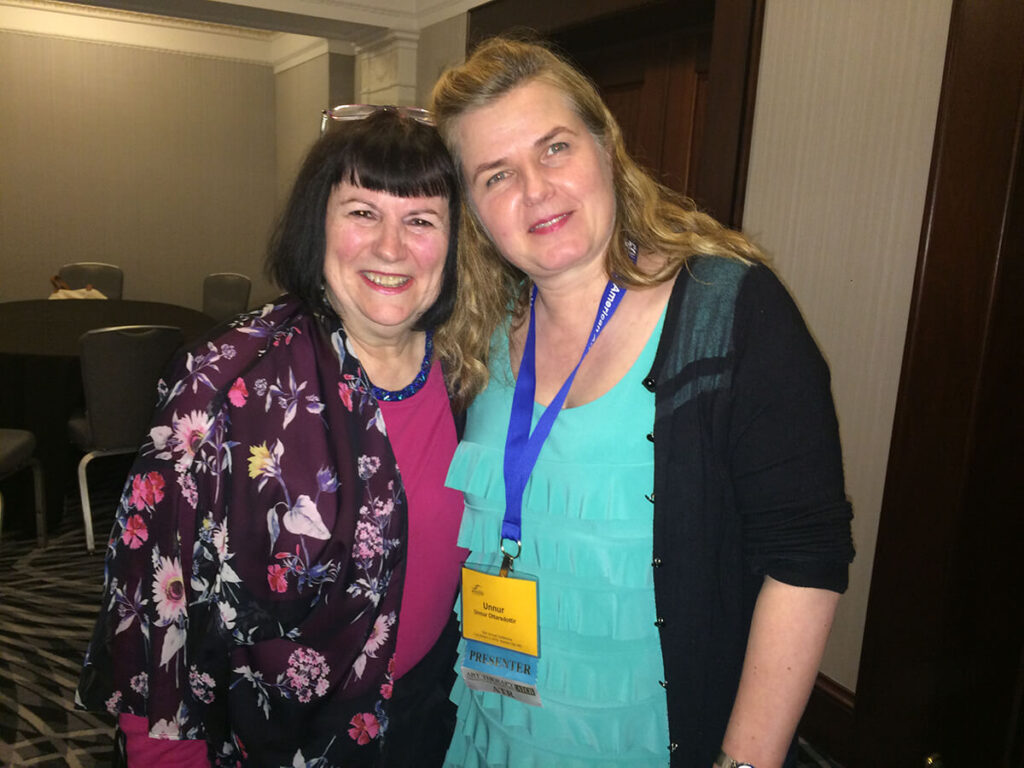
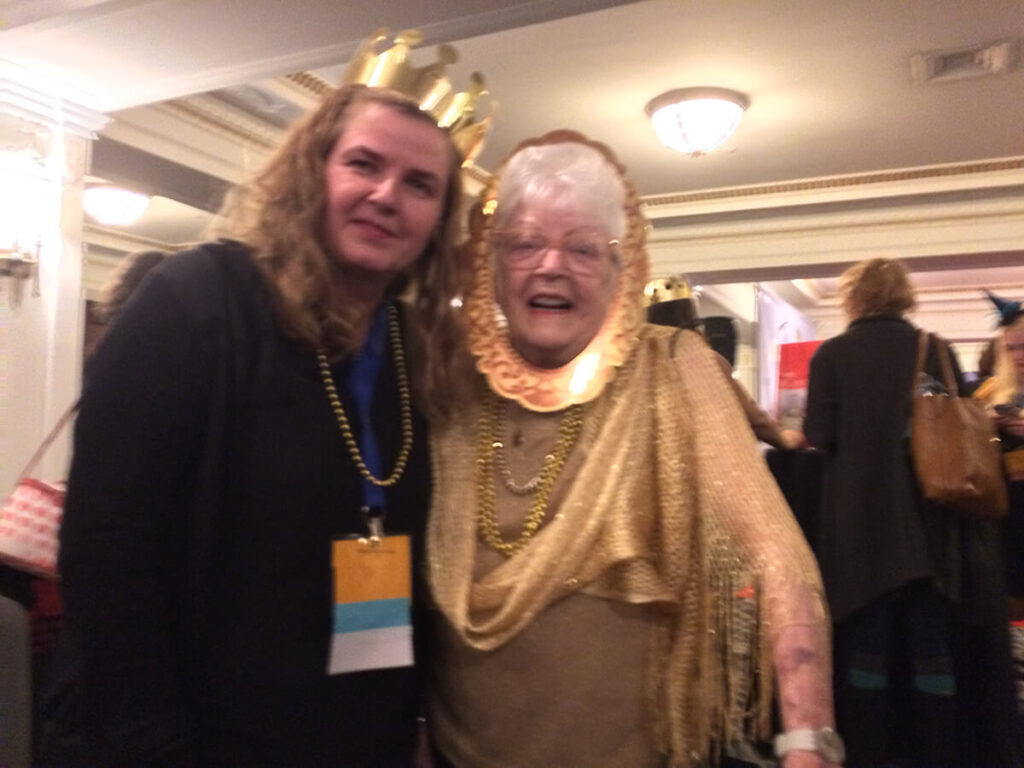
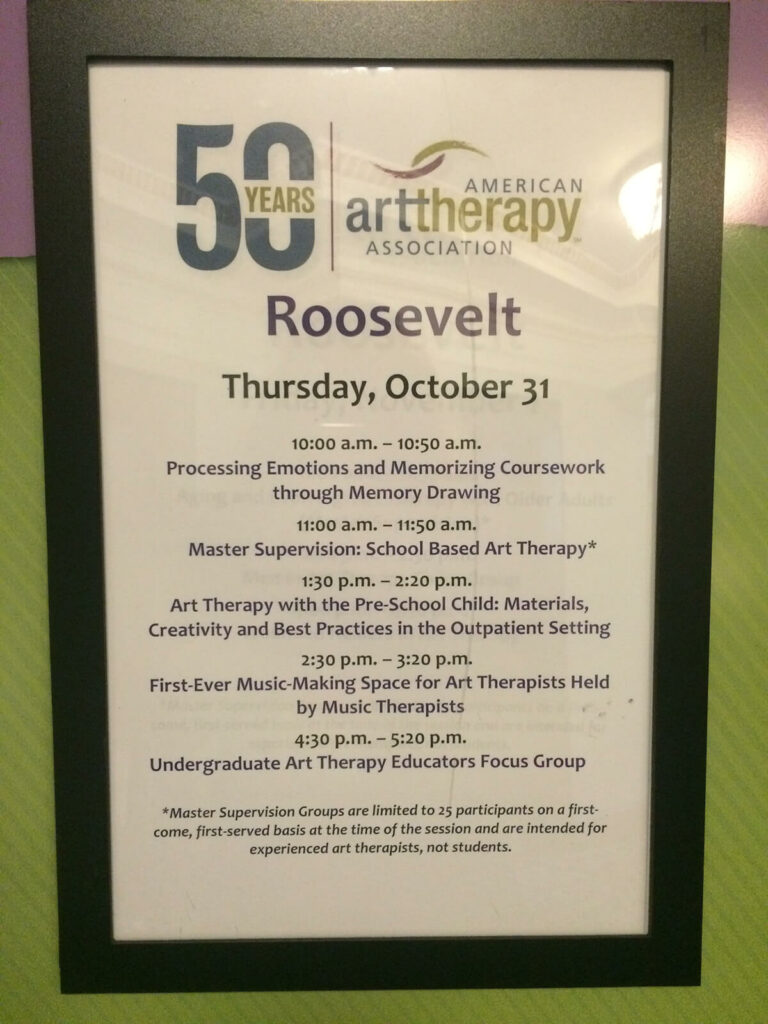
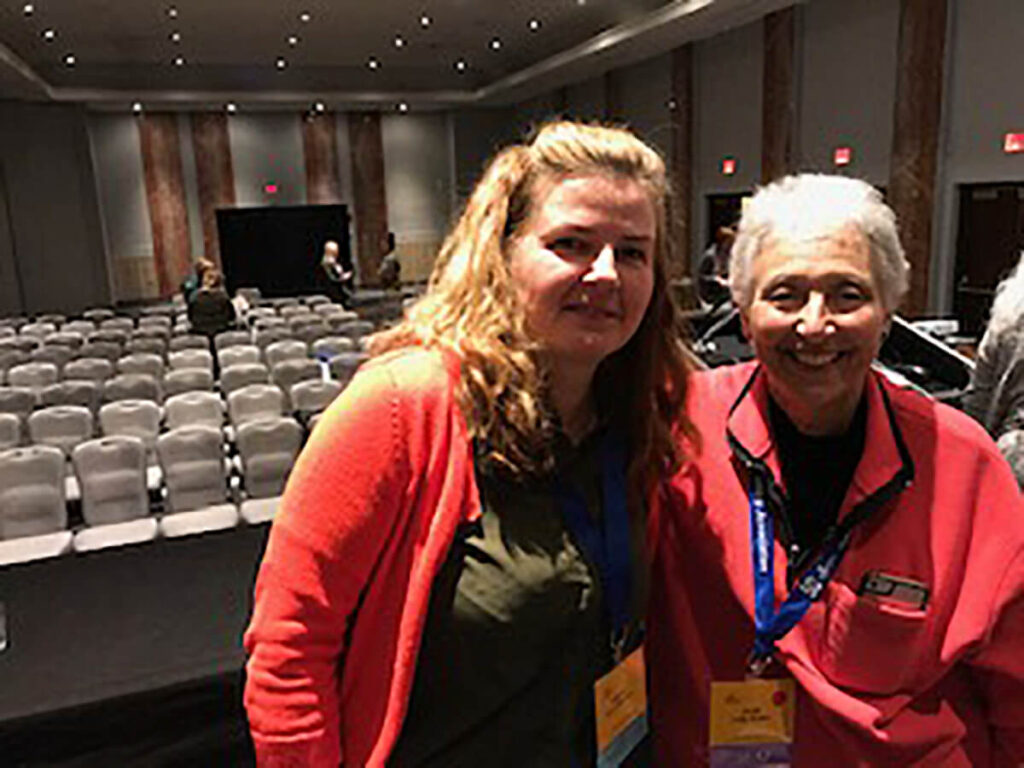
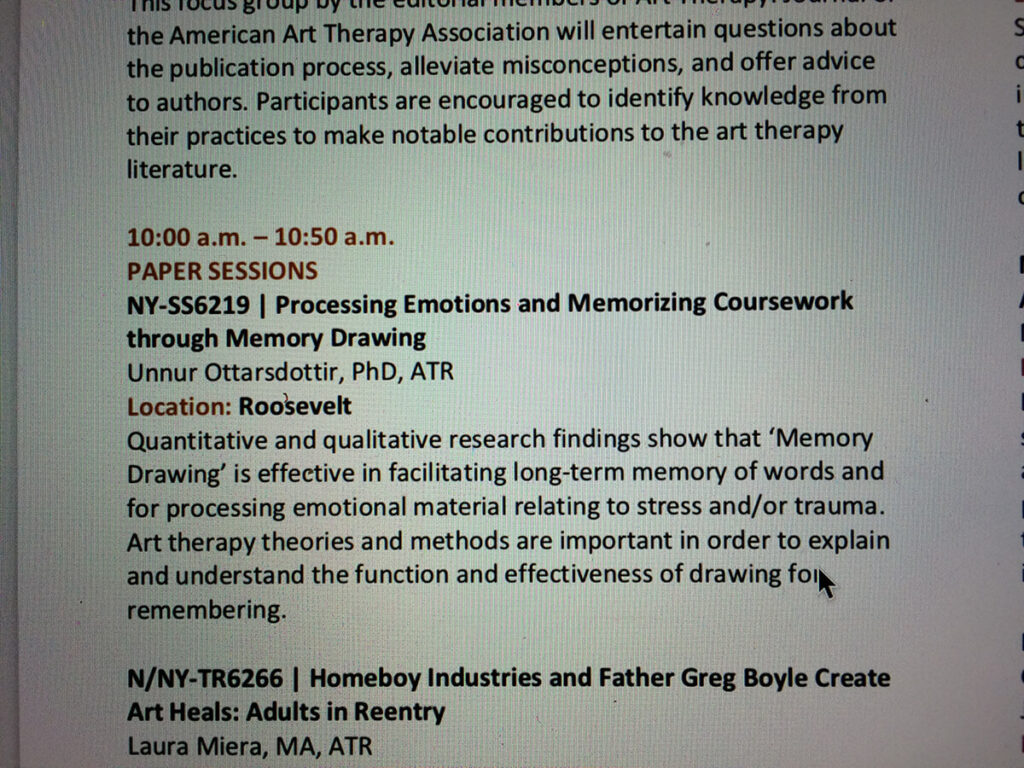
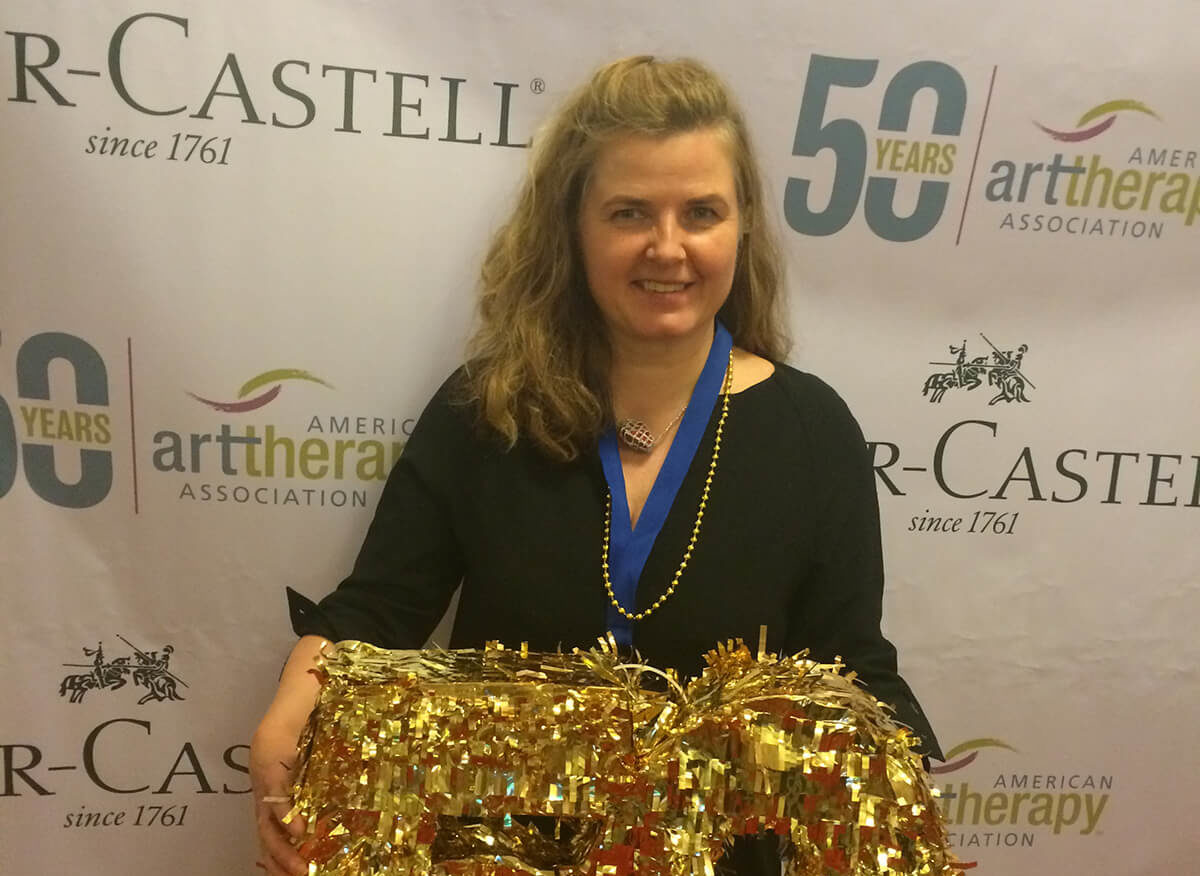
Celebrating 50 Years of Healing Through Art
30. október til 3. nóvember 2019 í Kansas City Marriott Downtown.
Quantitative and qualitative research on ‘Memory Drawing’ (Ottarsdottir, 2018; in press) which was conducted in the year 1999-2000 (Ottarsdottir, 2005) will be reviewed in the presentation.
Research about the effectiveness of drawing compared to writing, in facilitating memory over differing time frames will be reviewed. The way in which sensitive emotional material can be brought up and processed through such memory drawings will be demonstrated. The memory drawing research will be contextualised within the literature on related research studies, methods and theories. Examples of the application of the memory drawing method will be provided. Complexities of the therapeutic and educational processing included in memory drawing when applied within therapy or education will be considered in light of theories of art therapy and educational psychotherapy.
Memory of drawings and words was compared for 134 subjects in the quantitative part of the research, which aimed to investigate the effectiveness of drawing, compared to writing, in facilitating memory over short and long time periods. The research showed that drawing is effective in facilitating long-term memory. When drawing/writing was recalled three weeks following the original memorisation, the median amount of recalled words/drawings was two written words and five drawn. The research findings also showed that drawing is generally as much as five times more effective then writing for long-term memory when the drawings/words were recalled nine weeks after the original memorisation, without any recall within the nine weeks period. Research regarding such long-term memory of drawings has not been conducted prior to now.
Five children who had experienced stress and/or trauma and had specific learning difficulties participated in the qualitative case study part of the research. The aim of the research was to design, study and test a therapeutic method which would facilitate coursework learning, including memorising coursework, and enhancing the emotional well-being of the client. Theories of art therapy (e.g. Edwards, 2004) and educational psychotherapy (e.g. Best, 2014) contributed to the theoretical framework of the therapeutic method developed through the research. The qualitative case studies demonstrated the way in which memory drawing can facilitate coursework learning including memorisation.
In 2016, the psychologists Wammes, Meade, & Fernandes introduced their research which compared short-term memory of written and drawn words. Art therapy theories and methods are excluded in Wammes et al. (2016) research. Art therapy theories and methods were found to be important in terms of memory drawing in order to explore, understand and explain the function of memory drawing for processing emotions and facilitating memory of coursework. The memory drawing and the therapeutic process indicated that sensitive emotional material can be brought up and processed through such drawings. An art therapy framework was also found to be important for considering the ethics and drawing boundaries for the memory drawing method presented, in order to create safe spaces for students and clients who engage in creating memory drawings, especially within the classroom, when memory drawings are made by vulnerable pupils who have experienced stress and/or trauma and have lack of support in their lives.
Nánari upplýsingar: https://www.arttherapy.org/upload/ConferenceBrochure.pdf
Best, R. (2014). Educational psychotherapy: an approach to working with children whose learning is impeded by emotional problems. Support for Learning, 29(3), 201–216. https://doi.org/10.1111/1467-9604.12058
Edwards, D. (2004). Art therapy. London: Sage Publications.
Ottarsdottir, U. (in press). Ethical Concern when Applying Drawing for Memory: Research Conducted in Iceland. In: Audrey Di Maria (Ed.). Exploring Ethical Dilemmas in Art Therapy. England and USA: Routledge.
Ottarsdottir, U. (2018). Processing Emotions and Memorising Coursework through Memory Drawing. ATOL: Art Therapy OnLine, 9(1). Retrieved from: http://journals.gold.ac.uk/index.php/atol/article/view/486/pdf
Ottarsdottir, U. (2005). Art Therapy in Education: for Children with Specific Learning Difficulties who Have Experienced Stress and/or Trauma. Unpublished Ph.D. thesis, University of Hertfordshire, Hatfield.
Wammes, J. D., Meade, M. E., & Fernandes, M. A. (2016). The drawing effect: Evidence for reliable and robust memory benefits in free recall. The Quarterly Journal of Experimental Psychology, 69(9), 1752–1776. https://doi.org/10.1080/17470218.2015.1094494